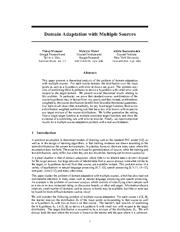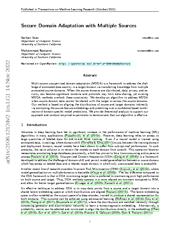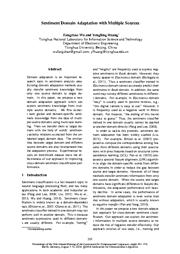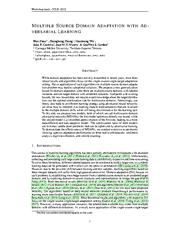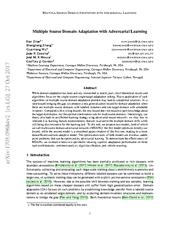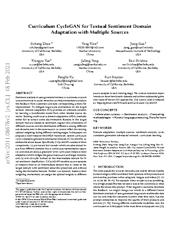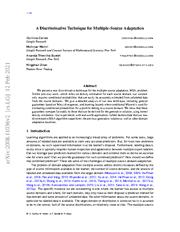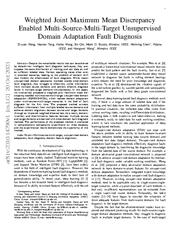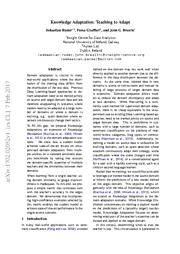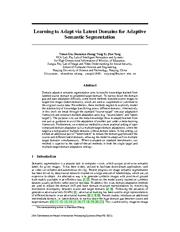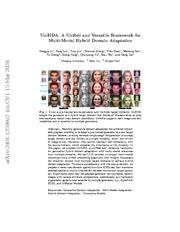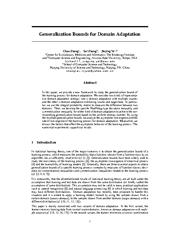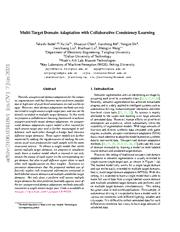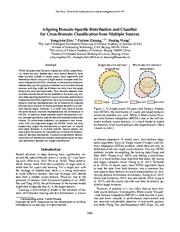A copy of this work was available on the public web and has been preserved in the Wayback Machine. The capture dates from 2016; you can also visit the original URL.
The file type is application/pdf.
Filters
Domain Adaptation with Multiple Sources
2008
Neural Information Processing Systems
This paper presents a theoretical analysis of the problem of domain adaptation with multiple sources. ...
Finally, we report empirical results for a multiple source adaptation problem with a real-world dataset. ...
We consider an adaptation problem with k source domains and a single target domain. ...
dblp:conf/nips/MansourMR08
fatcat:kmrlyvhqwbeebo7dcfkibscjoq
Secure Domain Adaptation with Multiple Sources
[article]
2022
arXiv
pre-print
Multi-source unsupervised domain adaptation (MUDA) is a framework to address the challenge of annotated data scarcity in a target domain via transferring knowledge from multiple annotated source domains ...
We develop an algorithm to address MUDA when source domain data cannot be shared with the target or across the source domains. ...
To account for applications with sensitive data, e.g. medical domains, we also forbid interaction between source models during adaptation. ...
arXiv:2106.12124v2
fatcat:h4q777pio5hj3hgk42o6hnknsq
Sentiment Domain Adaptation with Multiple Sources
2016
Proceedings of the 54th Annual Meeting of the Association for Computational Linguistics (Volume 1: Long Papers)
In this paper, we propose a new domain adaptation approach which can exploit sentiment knowledge from multiple source domains. ...
We first extract both global and domain-specific sentiment knowledge from the data of multiple source domains using multi-task learning. ...
Sentiment Domain Adaptation with Multiple Sources In this section we introduce our sentiment domain adaptation approach in detail. ...
doi:10.18653/v1/p16-1029
dblp:conf/acl/WuH16
fatcat:pvp3dtw7fjby5arqbde7ktntby
Multiple Source Domain Adaptation with Adversarial Learning
2018
International Conference on Learning Representations
We propose a new generalization bound for domain adaptation when there are multiple source domains with labeled instances and one target domain with unlabeled instances. ...
Naive application of such algorithms on multiple source domain adaptation problem may lead to suboptimal solutions. ...
Specifically, we prove a new generalization bound for domain adaptation when there are multiple source domains with labeled instances and one target domain with unlabeled instances. ...
dblp:conf/iclr/0002ZWCMG18
fatcat:5dn5ppqpjjbsfbgtxihl76jine
Multiple Source Domain Adaptation with Adversarial Training of Neural Networks
[article]
2017
arXiv
pre-print
As a step toward bridging the gap, we propose a new generalization bound for domain adaptation when there are multiple source domains with labeled instances and one target domain with unlabeled instances ...
Naive application of such algorithms on multiple source domain adaptation problem may lead to suboptimal solutions. ...
Specifically, we prove a new generalization bound for domain adaptation when there are multiple source domains with labeled instances and one target domain with unlabeled instances. ...
arXiv:1705.09684v2
fatcat:2pdyohyxhnhxhlncz2s2rahudq
Curriculum CycleGAN for Textual Sentiment Domain Adaptation with Multiple Sources
[article]
2021
arXiv
pre-print
with curriculum instance-level adaptation which bridges the gap across source and target domains, and (3) task classifier trained on the intermediate domain for final sentiment classification. ...
To mitigate large-scale annotations on the target domain, domain adaptation (DA) provides an alternate solution by learning a transferable model from other labeled source domains. ...
between multiple source domains and the target domain. ...
arXiv:2011.08678v2
fatcat:7gyajhdcynblvjgtcjcjrpgy4i
A Discriminative Technique for Multiple-Source Adaptation
[article]
2021
arXiv
pre-print
We present a new discriminative technique for the multiple-source adaptation, MSA, problem. ...
source domains. ...
These are some of the challenges of multiple-source domain adaptation. ...
arXiv:2008.11036v2
fatcat:bg5vq3vpmrbqpn5xcqwhiwu7ly
Weighted Joint Maximum Mean Discrepancy Enabled Multi-Source-Multi-Target Unsupervised Domain Adaptation Fault Diagnosis
[article]
2023
arXiv
pre-print
As a result, domain-invariant and discriminative features between multiple source and target domains are learned with cross-domain fault diagnosis realized. ...
While recent unsupervised domain adaptation methods enable cross-domain fault diagnosis, they struggle to effectively utilize information from multiple source domains and achieve effective diagnosis faults ...
However, in real scenarios, there are often multiple source domains or multiple target domains, and domain adaptation methods with a single-source-single-target domain might not obtain the optimal solution ...
arXiv:2310.14790v2
fatcat:bqss7i7nknh53loosmtu3b2mg4
Knowledge Adaptation: Teaching to Adapt
[article]
2017
arXiv
pre-print
We show how a student model achieves state-of-the-art results on unsupervised domain adaptation from multiple sources on a standard sentiment analysis benchmark by taking into account the domain-specific ...
Previous Deep Learning-based approaches to domain adaptation need to be trained jointly on source and target domain data and are therefore unappealing in scenarios where models need to be adapted to a ...
adaptation from multiple sources. ...
arXiv:1702.02052v1
fatcat:b6e7kmvnbzdujmiiga4zavla3i
Learning to Adapt via Latent Domains for Adaptive Semantic Segmentation
2021
Neural Information Processing Systems
Furthermore, we extend our method to a more practical setting of open compound domain adaptation (a.k.a multiple-target domain adaptation), where the target is a compound of multiple domains without domain ...
Alternatively, in this work we break through the standard "source-target" one pair adaptation framework and construct multiple adaptation pairs (e.g. "source-latent" and "latenttarget"). ...
"source→latent", "latent→latent", and "latent→target") for multiple-target domain adaptation (MT-DA), promoting the adapted model to perform well on multiple target domains simultaneously. ...
dblp:conf/nips/LiuZLY21
fatcat:dj5ejr7y5nhs5hvvkkbok2glti
UniHDA: A Unified and Versatile Framework for Multi-Modal Hybrid Domain Adaptation
[article]
2024
arXiv
pre-print
In this paper, we propose UniHDA, a unified and versatile framework for generative hybrid domain adaptation with multi-modal references from multiple domains. ...
To ensure consistency with the source domain, we propose a novel cross-domain spatial structure (CSS) loss that maintains detailed spatial structure information between source and target generator. ...
As shown in Fig. 9 , the results integrate the characteristics from multiple target domains and maintain robust consistency with the source domain. ...
arXiv:2401.12596v2
fatcat:ehuu3l7s55bdxh32wa7tcavpgm
Generalization Bounds for Domain Adaptation
2012
Advances in Neural Information Processing Systems
We consider two kinds of representative domain adaptation settings: one is domain adaptation with multiple sources and the other is domain adaptation combining source and target data. ...
In this paper, we provide a new framework to study the generalization bound of the learning process for domain adaptation. ...
for domain adaptation with multiple sources. ...
pmid:25309109
pmcid:PMC4191871
fatcat:5ozd7hxakbgrxcyi6ofsjm3nie
Multi-Target Domain Adaptation with Collaborative Consistency Learning
[article]
2021
arXiv
pre-print
However, most domain adaptation methods are only restricted to single-source-single-target pair, and can not be directly extended to multiple target domains. ...
An unsupervised domain adaptation expert model is first trained for each source-target pair and is further encouraged to collaborate with each other through a bridge built between different target domains ...
learned with unsupervised domain adaptation methods for each source-target domain pair. ...
arXiv:2106.03418v1
fatcat:l63vu5efafaatpr6fktudjwe7y
Aligning Domain-Specific Distribution and Classifier for Cross-Domain Classification from Multiple Sources
2019
PROCEEDINGS OF THE THIRTIETH AAAI CONFERENCE ON ARTIFICIAL INTELLIGENCE AND THE TWENTY-EIGHTH INNOVATIVE APPLICATIONS OF ARTIFICIAL INTELLIGENCE CONFERENCE
Thus, domain adapters from multiple sources should not be modeled in the same way. ...
Single-source Unsupervised Domain Adaptation (SUDA). ...
Multiple Feature Spaces Adaptation Network Learning common domain-invariant representations is difficult for multiple source domains. ...
doi:10.1609/aaai.v33i01.33015989
fatcat:nhfhsexs5jgqlm4psu4omqawwe
Unsupervised Domain Adaptation with Progressive Domain Augmentation
[article]
2020
arXiv
pre-print
Domain adaptation aims to exploit a label-rich source domain for learning classifiers in a different label-scarce target domain. ...
The proposed method generates virtual intermediate domains via domain interpolation, progressively augments the source domain and bridges the source-target domain divergence by conducting multiple subspace ...
Multiple Subspace Generation and Alignment We propose to adopt a multiple subspace alignment technique [33] to align the source domain with the virtual target domain. ...
arXiv:2004.01735v2
fatcat:neui2wauorglzd6ilxzedm6kb4
« Previous
Showing results 1 — 15 out of 971,207 results

